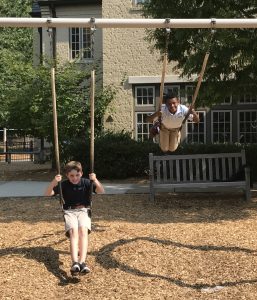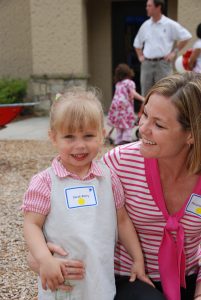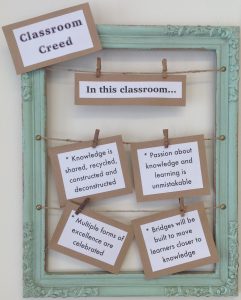
Chosen by the Sixth Graders, this year’s theme connected a little more personally to me. A little back story first. My younger daughter, Carly, was born in January 1998. When I nursed her at night, I would listen to the radio. During these early months, I would often hear the song “You Gotta Be” co-written and sung by the British artist, Des’ree. It seemed to me to be an anthem for my baby girl. As I look back at the lyrics now, I see that it could be the same for our students as well.
Listen as your day unfolds,
Challenge what the future holds
Try and keep your head up to the sky
Lovers, they may cause you tears
Go ahead release your fears,
Stand up and be counted
Don’t be ashamed to cry
Refrain:
You gotta be
You gotta be bad, you gotta be bold, you gotta be wiser
You gotta be hard, you gotta be tough, you gotta be stronger
You gotta be cool, you gotta be calm, you gotta stay together
All I know, all I know, love will save the day
Herald what your mother said
Read the books your father read
Try to solve the puzzles in your own sweet time
Some may have more cash than you
Others take a different view,
My oh my, heh, hey
Refrain
You gotta be
You gotta be bad, you gotta be bold, you gotta be wiser
You gotta be hard, you gotta be tough, you gotta be stronger
You gotta be cool, you gotta be calm, you gotta stay together
All I know, all I know, love will save the day
Time asks no questions,
It goes on without you
Leaving you behind if you can’t stand the pace
The world keeps on spinning
Can’t stop it, if you try to
The best part is danger staring you in the face
Listen as your day unfolds,
Challenge what the future holds
Try and keep your head up to the sky
Lovers, they may cause you tears
Go ahead release your fears,
Stand up and be counted
Don’t be ashamed to cry
Refrain:
You gotta be
You gotta be bad, you gotta be bold, you gotta be wiser
You gotta be hard, you gotta be tough, you gotta be stronger
You gotta be cool, you gotta be calm, you gotta stay together
All I know, all I know, love will save the day
As I think about our students, here are some lessons I hope they take from this song. I want them to “challenge what the future holds” and “stand up and be counted.” I encourage them to “solve the puzzles in (their) own sweet time.” I hope they will be bold, wise, tough, strong, cool, calm. Finally, I hope they remember that “love will save the day.” Not the syrupy, flowery kind of love, but the love that demands we fight for the rights of others and to be there for those in need, the kind of love that dispels the darkness and that can (and will) defeat evil. The love that is, well, … BOLD. May all our students leave Trinity with that bold love and spirit.



 As I have reflected upon her journey at Trinity School, and I have shed more than a few tears at this loss of childhood, I have been immensely proud of the school that has shaped Sarah, allowing her to stretch and honoring the gifts she brings so joyfully. Thank you, Trinity School, for helping my girl flourish.
As I have reflected upon her journey at Trinity School, and I have shed more than a few tears at this loss of childhood, I have been immensely proud of the school that has shaped Sarah, allowing her to stretch and honoring the gifts she brings so joyfully. Thank you, Trinity School, for helping my girl flourish.

